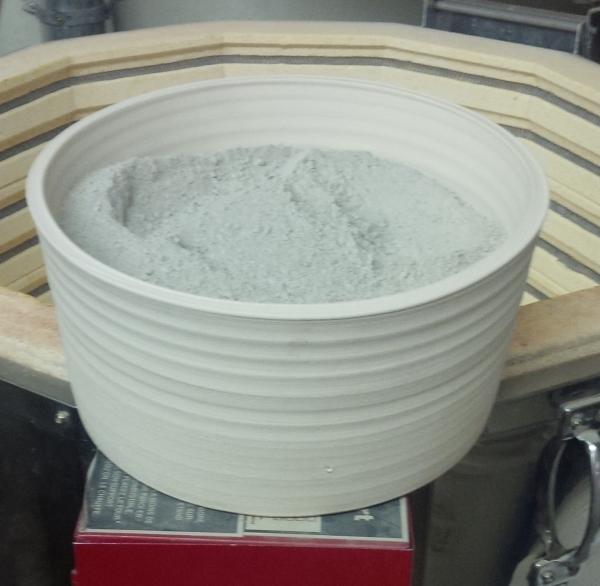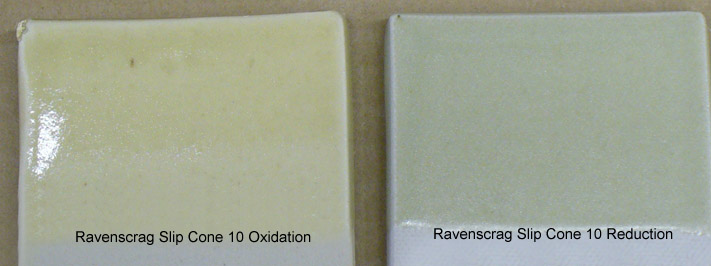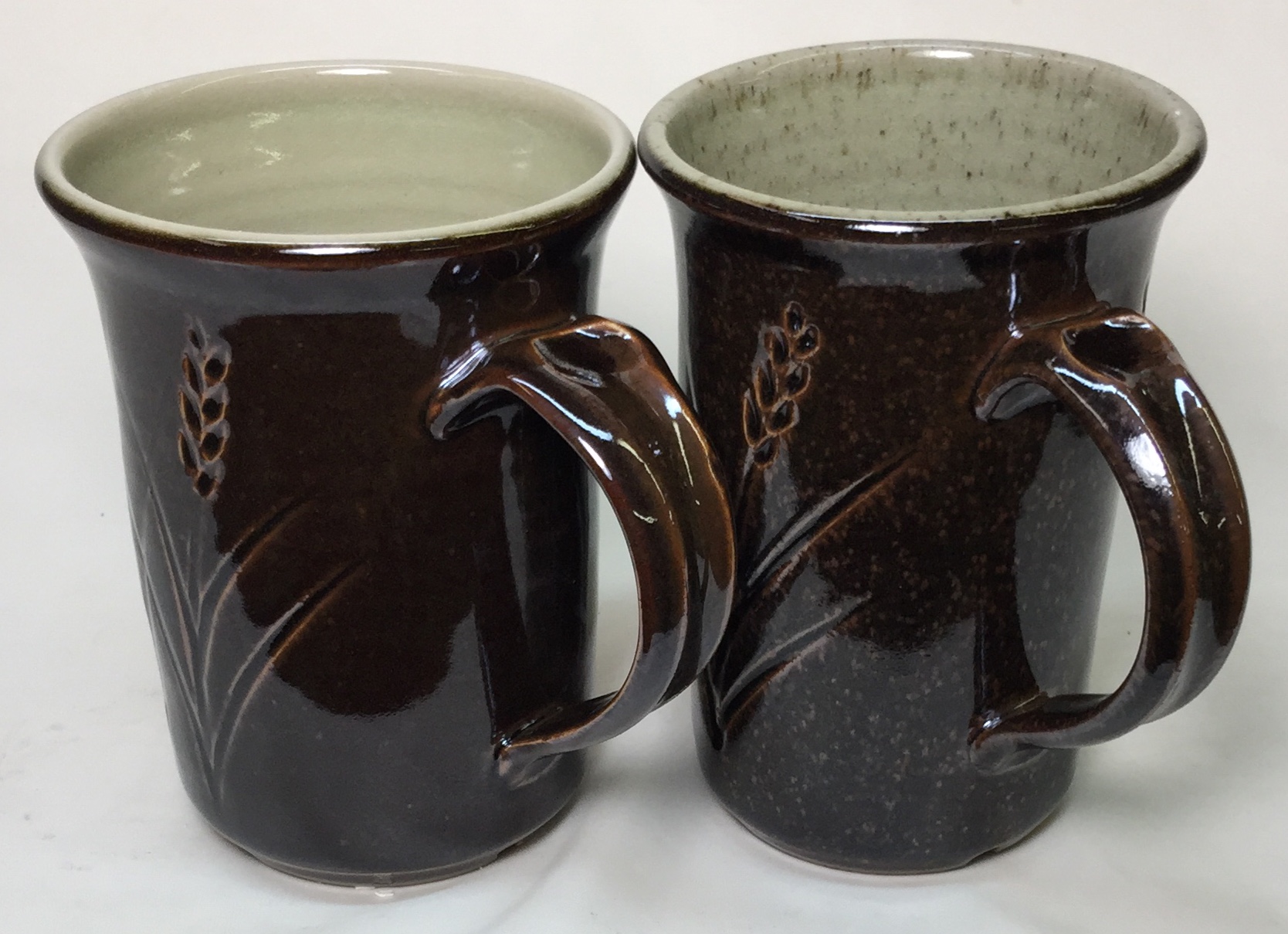| Monthly Tech-Tip | No tracking! No ads! | |
CELECG - Celestite Crystalline Glaze
FAAO - Fa's All-Opaque Crystalline Glaze
FAC5 - Crystal Number Five Glaze
FO - Octal Crystalline Glaze
G1214M - 20x5 Cone 6 Base Glossy Glaze
G1214W - Cone 6 Transparent Base
G1214Z1 - Cone 6 Silky CaO matte base glaze
G1215U - Low Expansion Glossy Clear Cone 6
G1216L - Transparent for Cone 6 Porcelains
G1216M - Cone 6 Ultraclear Glaze for Porcelains
G1916Q - Low Fire Highly-Expansion-Adjustable Transparent
G1947U - Cone 10 Glossy transparent glaze
G2000 - LA Matte Cone 6 Matte White
G2240 - Cone 10R Classic Spodumene Matte
G2571A - Cone 10 Silky Dolomite Matte glaze
G2826R - Floating Blue Cone 5-6 Original Glaze Recipe
G2826X - Randy's Red Cone 5
g2851H - Ravenscrag Cone 6 High Calcium Matte Blue
G2853B - Cone 04 Clear Ravenscrag School Glaze
G2896 - Ravenscrag Plum Red Cone 6
G2902B - Cone 6 Crystal Glaze
G2902D - Cone 6 Crystalline Development Project
G2916F - Cone 6 Stoneware/Whiteware transparent glaze
G2926B - Cone 6 Whiteware/Porcelain transparent glaze
G2926J - Low Expansion G2926B
G2928C - Ravenscrag Silky Matte for Cone 6
G2931H - Ulexite High Expansion Zero3 Clear Glaze
G2931K - Low Fire Fritted Zero3 Transparent Glaze
G2931L - Low Expansion Low-Fire Clear
G2934 - Matte Glaze Base for Cone 6
G2934Y - Cone 6 Magnesia Matte Low LOI Version
G3806C - Cone 6 Clear Fluid-Melt transparent glaze
G3838A - Low Expansion Transparent for P300 Porcelain
G3879 - Cone 04 Transparent Low-Expansion transparent glaze
GA10-A - Alberta Slip Base Cone 10R
GA10-B - Alberta Slip Tenmoku Cone 10R
GA10-D - Alberta Slip Black Cone 10R
GA10x-A - Alberta Slip Base for cone 10 oxidation
GA6-A - Alberta Slip Cone 6 transparent honey glaze
GA6-B - Alberta Slip Cone 6 transparent honey glaze
GA6-C - Alberta Slip Floating Blue Cone 6
GA6-D - Alberta Slip Glossy Brown Cone 6
GA6-F - Alberta Slip Cone 6 Oatmeal
GA6-G - Alberta Slip Lithium Brown Cone 6
GA6-G1 - Alberta Slip Lithium Brown Cone 6 Low Expansion
GA6-H - Alberta Slip Cone 6 Black
GBCG - Generic Base Crystalline Glaze
GC106 - GC106 Base Crystalline Glaze
GR10-A - Pure Ravenscrag Slip
GR10-B - Ravenscrag Cone 10R Gloss Base
GR10-C - Ravenscrag Cone 10R Silky Talc Matte
GR10-E - Alberta Slip:Ravenscrag Cone 10R Celadon
GR10-G - Ravenscrag Cone 10 Oxidation Variegated White
GR10-J - Ravenscrag Cone 10R Dolomite Matte
GR10-J1 - Ravenscrag Cone 10R Bamboo Matte
GR10-K1 - Ravenscrag Cone 10R Tenmoku
GR10-L - Ravenscrag Iron Crystal
GR6-A - Ravenscrag Cone 6 Clear Glossy Base
GR6-B - Ravenscrag Cone 6 Variegated Light Glossy Blue
GR6-C - Ravenscrag Cone 6 White Glossy
GR6-D - Ravenscrag Cone 6 Glossy Black
GR6-E - Ravenscrag Cone 6 Raspberry Glossy
GR6-H - Ravenscrag Cone 6 Oatmeal Matte
GR6-L - Ravenscrag Cone 6 Transparent Burgundy
GR6-M - Ravenscrag Cone 6 Floating Blue
GR6-N - Ravenscrag Alberta Brilliant Cone 6 Celadon
GRNTCG - GRANITE Crystalline Glaze
L2000 - 25 Porcelain
L3341B - Alberta Slip Iron Crystal Cone 10R
L3685U - Cone 03 White Engobe Recipe
L3724F - Cone 03 Terra Cotta Stoneware
L3924C - Zero3 Porcelain Experimental
L3954B - Cone 6 Engobe (for M340)
L3954N - Cone 10R Base White Engobe Recipe for stonewares
MGBase1 - High Calcium Semimatte 1 (Mastering Glazes)
MGBase2 - High Calcium Semimatte 2 (Mastering Glazes)
MGBase3 - General Purpose Glossy Base 1 (Mastering Glazes)
MGBase4 - Glossy Base 2 Cone 6 (Mastering Glazes)
MGBase5 - Glossy Clear Liner Cone 6 (Mastering Glazes)
MGBase6 - Zinc Semimatte Glossy Base Cone 6
MGBase7 - Raspberry Cone 6 (Mastering Glazes)
MGBase8 - Waxwing Brown Cone 6 (Mastering Glazes)
MGBase9 - Waterfall Brown Cone 6 (Mastering Glazes)
TNF2CG - Tin Foil II Crystalline Glaze
VESUCG - Vesuvius Crystalline Glaze
Insight-Live Shares (also referencing this recipe)
These add technical detail, development info, variations and improvements.
GR10-A - Pure Ravenscrag Slip
Modified: 2023-09-19 22:34:46
Ravenscrag all by itself makes a great cone 10 reduction semi-gloss glaze. It also has great working properties.
| Material | Amount |
|---|---|
| Ravenscrag Slip 1000F Roast | 50.00 |
| Ravenscrag Slip | 50.00 |
| 100.00 | |
Notes
Ravenscrag Slip is a revolutionary glaze material for stoneware. At cone 10R it can be used pure and produces a functional semi-gloss surface. The possibilities are endless on what you can do by adding things to this base material. You can make additions to gloss it or matte it more, color and variegate it and/or opacify it. Most will contain 90% Ravenscrag (you can make bamboo, tenmoku, celadon, iron crystal, white, matte, glossy, and much more).
Ravenscrag Slip is a clay, so it shrinks. We recommend starting a 50:50 raw:roast mix in recipes that call for a high percentage of the material (use the roast instructions at http://ravenscrag.com). Adjust the proportion to get the fastest drying possible while still drying hard and having good slurry suspension. Ravenscrag glazes resist settling in the bucket and go on even (when mixed correctly).
Glazes having a high percentage of Ravenscrag Slip are most often prepared using the traditional method of simply adding water until the preferred viscosity is achieved (the material has inherent properties that produce functional slurries for dipping). Control of drying shrinkage and slurry character is achieved by varying the proportion roast and raw powder in the recipe. For us, a weight ratio of 88 water to 100 powder (2200 tap water for 2.5kg of powder) produces a creamy slurry that gives the right thickness on 1-2 second dip on 1850F bisque-ware (with minimal dripping), it has 1.45-1.47-specific-gravity. Using your water you will likely find some variation in this. This recipe actually does not respond to flocculant additions that gel traditional mineral-blend glazes to a thixotropic state.
3000 grams of powder mix makes about 1 Canadian gallon.
Related Information
Sterile white vs. pure Ravenscrag Slip as a liner glaze at cone 10R

This picture has its own page with more detail, click here to see it.
This picture does not fully convey how much better the Ravenscrag is as a liner glaze (vs. G1947U). It has depth and looks much richer. It course, it could be opacified somewhat to be whiter and would still retain the surface quality (as long is it is not too opaque). The body is Plainsman H450. The outside glaze is pure Alberta Slip.
Roast or calcine your Ravenscrag Slip (or other clays) for much better results

This picture has its own page with more detail, click here to see it.
Calcined or roasted clays are indispensable in making many types of glazes, they reduce drying shrinkage (and thus cracking and crawling) compared to those made using raw clay. In a glaze, you can fine-tune a mix of raw and roast clay to achieve a compromise between dry hardness and low shrinkage.
This is Ravenscrag Slip, we roast it to 1000F (roasting is adequate to destroy plasticity and produces a smoother powder than calcining at higher temperatures). To make sure the heat penetrates for this size vessel I hold it for 2 hours at 1000F. Calcined koalin is getting harder to find, this same process can be used to make your own from a raw kaolin powder. One thing is worth noting: Weight lost on firing actually means that less of the roasted powder is needed to yield the same amount of material to the glaze melt, it can be anywhere from 5-12% less.
G1947U transparent glaze (left) vs. Ravenscrag Slip at cone 10R

This picture has its own page with more detail, click here to see it.
Ravenscrag Slip is not ultra glossy but has a silky surface. It also contains some iron oxide and this colors the glaze somewhat. But the surface is much less sterile and pleasant to touch.
100% Ravenscrag slip on Plainsman H550 stoneware fired to cone 10R

This picture has its own page with more detail, click here to see it.
The surface is between silky and glossy.
CaO is a strong flux but it can cause crazing

This picture has its own page with more detail, click here to see it.
2, 5, 10, 15% calcium carbonate added to Ravenscrag Slip on a buff stoneware fired at cone 10R. It gets progressively glossier toward 15%, crazing starts at 10% (test by Kat Valenzuela). Adding a flux only reduces the SiO2 and Al2O3, this pushes the thermal expansion upwards. 5% is actually sufficient. An alternative would be to use wollastonite, it supplies SiO2 also.
How to matte Ravenscrag Slip at cone 10 by adding talc

This picture has its own page with more detail, click here to see it.
2,5,10,15% talc added to Ravenscrag Slip on a buff stoneware fired at cone 10R. Matting begins at 10%. By Kat Valenzuela.
2, 5, 10, 15% dolomite added to Ravenscrag Slip at cone 10R

This picture has its own page with more detail, click here to see it.
This is a buff stoneware clay. Crystal development toward a dolomite matte begins at 15%. By Kat Valenzuela.
2, 5, 10 and 15% alumina hydrate added to Ravenscrag Slip

This picture has its own page with more detail, click here to see it.
Pure Ravenscrag Slip is glaze-like by itself (thus tolerating the alumina addition while still melting as a glaze). It was applied on a buff stoneware which was then fired at cone 10R (by Kat Valenzuela). This same test was done using equal additions of calcined alumina. The results suggest that the hydrated version is decomposing to yield some of its Al2O3, as an oxide, to the glaze melt. By 15% it is matting and producing a silky surface. However crazing also starts at 10%. The more Al2O3 added the lower the glaze expansion should be, so why is this happening? It appears that the disassociation is not complete, raw material remains to impose its high expansion.
Ravenscrag Slip pure: Oxidation vs. Reduction

This picture has its own page with more detail, click here to see it.
Pure Ravenscrag Slip on a porcelain at cone 10 oxidation (left) and cone 10 reduction (right). The reduction fired sample is a very smooth pleasant semi-matte, the other is glossier but dimpled.
Laguna B-Mix, B-Mix+Fireclay with Ravenscrag GR10-A, GR10-C glazes

This picture has its own page with more detail, click here to see it.
Left two mugs are glazed with pure Ravenscrag Slip (roast:raw combo), far right one is RavenTalc silky matte (GR10-C). The speckled mugs have 10% of a Plainsman Fire-Red (a blend of a red fireclay, M2 and a heavily speckled ball clay). Ravenscrag Slip is an ideal base for cone 10R glazes, so many glazes can be made by adding pigments, opacifiers, variegators and matting agents.
B-Mix with Ravenscrag Slip inside and Alberta Slip outside

This picture has its own page with more detail, click here to see it.
Fired cone 10R. The one on the right contains 10% of Plainsman A1:St Rose Red mix to add speckle.
2, 5, 10 and 15% calcined alumina added to Ravenscrag Slip

This picture has its own page with more detail, click here to see it.
The Ravenscag:Alumina mix was applied to a buff stoneware fired at cone 10R (by Kat Valenzuela). Matting begins at only 5% producing a very dry surface by 15%. This "psuedo matte" surface is simply a product of the refractory nature of the alumina as a material, it does not disassociate in the melt to yield its Al2O3 as an oxide (as would a feldspar, frit or clay). The same test using alumina hydrate demonstrates that it disassociates somewhat better (although not completely).
Laguna B-Mix Cone 10R mugs with Alberta and Ravenscrag glazes

This picture has its own page with more detail, click here to see it.
B-Mix is a popular high-ball clay very plastic grey cone 10R stoneware in North America. The two mugs on the left have pure Ravenscrag Slip on the inside (the middle on the outside also), it fires almost transparent with a slightly silky surface. Pure Alberta Slip is employed on the outside of the left one and the inside of the right one. The outside of the right one is RavenTalc silky matte. In all cases the Ravenscrag and Alberta Slip are mixed half-and-half calcined and raw. B-Mix fires dark enough and with enough specks that a normal transparent glaze is not very interesting. But these Ravenscrag ones look much better (for use as a liner glaze).
Links
| URLs |
https://plainsmanclays.com/data/index.php?product=12911
Ravenscrag Data Sheet at Plainsman Clays |
| URLs |
http://ravenscrag.com
Ravenscrag web site |
| Firing Schedules |
Plainsman Cone 10R Firing
Six-step oxidize-at-end schedule to 2372F |
| Typecodes |
Ravenscrag Slip Recipes
Recipes based on Ravenscrag Slip from Plainsman Clays. |
| Typecodes |
High Temperature (Cone 10) Glaze Recipes
Normally reduction gas fired. |
| Recipes |
GR10-C - Ravenscrag Cone 10R Silky Talc Matte
Just Ravenscrag Slip plus 10% talc produces a visually variegated surface that feels silky and looks stunning! |
XML to Paste Into Insight-live
<?xml version="1.0"?> <recipes version="1.0" encoding="UTF-8"> <recipe name="Pure Ravenscrag Slip" keywords="Ravenscrag all by itself makes a great cone 10 reduction semi-gloss glaze. It also has great working properties." id="58" date="2023-09-19" codenum="GR10-A"> <recipelines> <recipeline material="Ravenscrag Slip 1000F Roast" amount="50.000"/> <recipeline material="Ravenscrag Slip" amount="50.000"/> <url url="https://digitalfire.com/recipe/58" descrip="https://digitalfire.com/recipe/58"/> </recipelines> <urls/> </recipe> </recipes>
| By Tony Hansen Follow me on        |  |
Got a Question?
Buy me a coffee and we can talk

https://digitalfire.com, All Rights Reserved
Privacy Policy
